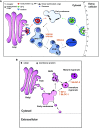The life cycle of platelet granules
- PMID: 29560259
- PMCID: PMC5832915
- DOI: 10.12688/f1000research.13283.1
The life cycle of platelet granules
Abstract
Platelet granules are unique among secretory vesicles in both their content and their life cycle. Platelets contain three major granule types-dense granules, α-granules, and lysosomes-although other granule types have been reported. Dense granules and α-granules are the most well-studied and the most physiologically important. Platelet granules are formed in large, multilobulated cells, termed megakaryocytes, prior to transport into platelets. The biogenesis of dense granules and α-granules involves common but also distinct pathways. Both are formed from the trans-Golgi network and early endosomes and mature in multivesicular bodies, but the formation of dense granules requires trafficking machinery different from that of α-granules. Following formation in the megakaryocyte body, both granule types are transported through and mature in long proplatelet extensions prior to the release of nascent platelets into the bloodstream. Granules remain stored in circulating platelets until platelet activation triggers the exocytosis of their contents. Soluble N-ethylmaleimide-sensitive factor attachment protein receptor (SNARE) proteins, located on both the granules and target membranes, provide the mechanical energy that enables membrane fusion during both granulogenesis and exocytosis. The function of these core fusion engines is controlled by SNARE regulators, which direct the site, timing, and extent to which these SNAREs interact and consequently the resulting membrane fusion. In this review, we assess new developments in the study of platelet granules, from their generation to their exocytosis.
Keywords: Exocytosis; Granule; Platelet activation; Platelets.
Conflict of interest statement
No competing interests were disclosed.No competing interests were disclosed.No competing interests were disclosed.
Figures


References
Publication types
Grants and funding
LinkOut - more resources
Full Text Sources
Other Literature Sources

